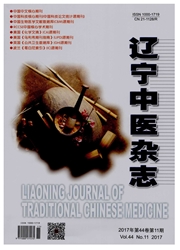

 中文摘要:
中文摘要:
目的:观察针刺对自发性高血压大鼠(SHR)血压的影响,从氧化/抗氧化酶角度探讨针刺降压机制。方法:将SHR随机分为针刺组、模型组,以京都Wistar大鼠(WKY)作为血压正常的对照组。针刺组取双侧人迎穴,施以捻转手法,捻转频率为120~160次/min,行针1 min,每日针刺1次;模型组和正常组进行与针刺组相同时间、相同程度的捉抓。针刺前、针刺1周末、2周末、3周末、4周末测量收缩压和舒张压。针刺4周后,取胸主动脉,ELISA法测定NADPH氧化酶含量,可见光法检测CAT活性。结果:模型组血压呈现出随周龄增长而波动升高的趋势。针刺组在针刺第1周末即出现血压降低的效应,其中收缩压在第3周末和第4周末与模型组比较明显降低(P〈0.05),针刺组舒张压与模型组比较虽然无统计学差异,但总体上呈现降低的趋势。针刺组的NADPH氧化酶含量低于模型组(P〈0.05),CAT活性高于模型组(P〈0.05)。结论:针刺可降低SHR随周龄而升高的血压,具有明确的降压效应。SHR体内存在NADPH氧化酶过高和CAT过低的氧化应激状态,针刺对该两种酶的良性调节可能是针刺降压的抗氧化机制之一。
 英文摘要:
英文摘要:
Objective : To observe the effects of acupuncture on SHR blood pressure, and research the mechanisms from the per- spective of oxidation/antioxidant enzymes. Methods : To separate the SHRs into acupuncture group and model group randomly, WKYs as normal blood pressure controlled group. To acupuncture group, acupuncture with the twirling manipulation, frequency 120 - 160/min,lasting 1 min. Model group and normal group were treated by the same crawl stimulation. The blood pressure was measured before and at the end of 1 st week,2nd week,3rd week and 4th week treatment. After 4 weeks of treatment, all the rats were decapitated and get the thoracic aorta. The content of NADPH oxidase enzyme and activity of CAT was measured by means of ELISA chemiluminiscene respectively. Results : The blood pressure in model group was increased volatility with week - old. The blood pressure in acupuncture group has shown signs of reducing at the end of 1 st week, among which, at the end of 3rd and 4th week, systolic blood pressure in acupuncture group was significantly reduced compared with model group (P 〈 0. 05 ) ; the diastolic blood pressure in acupuncture group was no significantly difference compared with model group, but has shown the tendency of re- ducing in the whole. The content of NADPH oxidase enzyme in acupuncture group was lower than model group( P 〈 0. 05 ), and the activity of CAT was higher than model group( P 〈 0. 05 ). Conclusion : acupuncture can reduce the blood pressure of SHR which increasing with week - old, thus antihypertensive effects is clear. There is NADPH oxidation enzyme too high and CAT too low in SHR. The one of acupuncture antihypertensive mechanisms may be related to regulate those two enzymes.
 同期刊论文项目
同期刊论文项目
 同项目期刊论文
同项目期刊论文
 期刊信息
期刊信息
